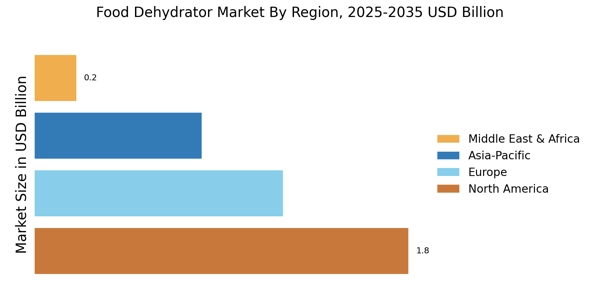Rising Demand for Healthy Snacks
The Food Dehydrator Market is experiencing a notable increase in demand for healthy snacks. As consumers become more health-conscious, they are seeking alternatives to traditional snacks that are often high in preservatives and artificial ingredients. Dehydrated fruits and vegetables are perceived as nutritious options, appealing to a wide demographic. According to recent data, the market for healthy snacks is projected to grow at a compound annual growth rate of approximately 8% over the next five years. This trend is likely to drive the sales of food dehydrators, as individuals look to create their own healthy snacks at home, thus fostering a burgeoning market for food dehydrators.
Increased Interest in Home Cooking
The Food Dehydrator Market is benefiting from a surge in interest in home cooking. As more individuals engage in culinary activities at home, the demand for kitchen appliances, including food dehydrators, is on the rise. This trend is supported by data indicating that home cooking has increased by nearly 30% in recent years. Consumers are increasingly looking for ways to preserve food and create unique flavors, which food dehydrators facilitate. The ability to dehydrate fruits, vegetables, and even meats at home aligns with the growing desire for self-sufficiency and culinary creativity, thereby enhancing the market potential for food dehydrators.
Sustainability and Waste Reduction
The Food Dehydrator Market is also influenced by a growing emphasis on sustainability and waste reduction. Consumers are becoming more aware of food waste issues and are actively seeking solutions to minimize it. Food dehydrators offer a practical method for preserving surplus produce, thus reducing waste. Recent statistics suggest that nearly 30% of food produced is wasted, prompting consumers to adopt practices that promote sustainability. By utilizing food dehydrators, individuals can extend the shelf life of their food, contributing to a more sustainable lifestyle. This shift in consumer behavior is likely to bolster the food dehydrator market as environmentally conscious choices gain traction.
Growing Popularity of DIY Food Preservation
The Food Dehydrator Market is experiencing a rise in the popularity of DIY food preservation methods. As consumers become more interested in self-sufficiency and artisanal food preparation, the use of food dehydrators is becoming more prevalent. This trend is reflected in the increasing number of online resources and communities dedicated to food preservation techniques. Data suggests that the DIY food preservation market is projected to grow significantly, with food dehydrators playing a crucial role in this movement. The ability to create personalized snacks and preserve seasonal produce aligns with consumer desires for authenticity and quality, thereby driving the food dehydrator market.
Technological Innovations in Food Dehydrators
The Food Dehydrator Market is witnessing advancements in technology that enhance the functionality and efficiency of food dehydrators. Innovations such as digital controls, energy-efficient designs, and improved drying methods are making these appliances more appealing to consumers. Data indicates that the introduction of smart dehydrators, which can be controlled via mobile applications, is gaining popularity. These technological advancements not only improve user experience but also cater to the needs of tech-savvy consumers. As manufacturers continue to innovate, the market for food dehydrators is expected to expand, driven by the demand for more efficient and user-friendly appliances.


















Leave a Comment